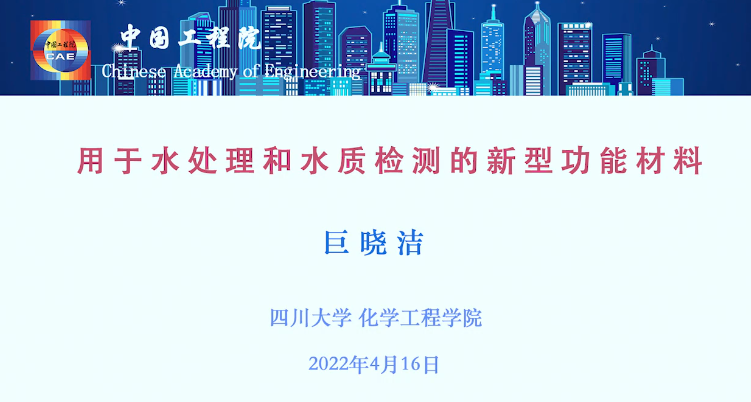检索范围:
排序: 展示方式:

刘更另
《中国工程科学》 2000年 第2卷 第7期 页码 39-42
文章从水性质特点谈到中国水资源的问题,认为不能单纯用年平均降雨量的多少来判定中国水资源的状况,水资源开发利用的好坏决定于人类社会的调节和管理。中国水资源总的来说是够用的,最大问题是降水量的时空分布不平衡。
中国农民几千年来创造了许多治水蓄水用水的经验。农业节水非常重要,关键在"分散蓄水,分散使用",以减少径流在汇集和分散过程中的损失和污染,在提高水的利用效率方面有一系列的科研和实际工作要做。

Daniel P. LOUCKS, Haifeng JIA
《环境科学与工程前沿(英文)》 2012年 第6卷 第2期 页码 255-264 doi: 10.1007/s11783-011-0359-6
关键词: water stress aquatic ecosystems sustainable water resource allocations ecosystem water requirements
《环境科学与工程前沿(英文)》 2024年 第18卷 第2期 doi: 10.1007/s11783-024-1778-5
● Most water samples had excellent quality and negligible or acceptable health risks.
关键词: Drinking water quality Water quality index Health risk assessment Secondary water supply systems Heavy metals
La ZHUO, Arjen Y. HOEKSTRA
《农业科学与工程前沿(英文)》 2017年 第4卷 第2期 页码 185-194 doi: 10.15302/J-FASE-2017149
关键词: field management irrigation efficiency water footprint water productivity water use efficiency
Xiaojian ZHANG , Chao CHEN ,
《环境科学与工程前沿(英文)》 2009年 第3卷 第3期 页码 364-368 doi: 10.1007/s11783-009-0027-2
关键词: emergency drinking water treatment water pollution adsorption oxidation precipitation
Bioinspired and biomimetic membranes for water purification and chemical separation: A review
《环境科学与工程前沿(英文)》 2021年 第15卷 第6期 doi: 10.1007/s11783-021-1412-8
•The history of biological and artificial water channels is reviewed.
关键词: Aquaporins Artificial water channels Biomimetic membranes Chemical separation and water purification
Feng Wang, Weiying Li, Yue Li, Junpeng Zhang, Jiping Chen, Wei Zhang, Xuan Wu
《环境科学与工程前沿(英文)》 2018年 第12卷 第3期 doi: 10.1007/s11783-018-1020-4
关键词: Bacterial community Water age High-throughput sequencing technique Drinking water distribution system
ZHANG Xiaojian,MI Zilong,WANG Yang,LIU Shuming,NIU Zhangbin,LU Pinpin,WANG Jun,GU Junnong,CHEN Chao
《环境科学与工程前沿(英文)》 2014年 第8卷 第3期 页码 417-426 doi: 10.1007/s11783-013-0558-4
关键词: iron release drinking water distribution system sulphate phosphate red water control water quality stability
Ting Zhang, Heze Liu, Yiyuan Zhang, Wenjun Sun, Xiuwei Ao
《环境科学与工程前沿(英文)》 2020年 第14卷 第3期 doi: 10.1007/s11783-020-1214-4
关键词: Drinking water Treatment process Genotoxicity Umu test Ecological Structure-Activity Relationship
Haiyan Yang, Shangping Xu, Derek E. Chitwood, Yin Wang
《环境科学与工程前沿(英文)》 2020年 第14卷 第5期 doi: 10.1007/s11783-020-1254-9
关键词: Point-of-use water treatment Ceramic water filter Bacterial removal Surface modification Water quality
Nanofiltration for drinking water treatment: a review
《化学科学与工程前沿(英文)》 2022年 第16卷 第5期 页码 681-698 doi: 10.1007/s11705-021-2103-5
关键词: nanofiltration drinking water disinfection byproducts micropollutants selectivity
Water, energy and food interactions–Challenges and opportunities
Gustaf OLSSON
《环境科学与工程前沿(英文)》 2013年 第7卷 第5期 页码 787-793 doi: 10.1007/s11783-013-0526-z
关键词: water security energy security food security water-energy nexus water conflicts
Zhaoxing HAN, Zhenyao SHEN, Yongwei GONG, Qian HONG
《环境科学与工程前沿(英文)》 2011年 第5卷 第1期 页码 119-129 doi: 10.1007/s11783-011-0272-z
关键词: emission trading water functional zone water quality control
标题 作者 时间 类型 操作
巨晓洁:用于水处理和水检测的新型功能材料(2022年4月16日)
2022年06月09日
会议视频
王光谦:全球水循环与水资源利用(2019年10月17日)
王光谦(院士)
2021年01月20日
会议视频
Drinking water quality & health risk assessment of secondary water supply systems in residential neighborhoods
期刊论文
The effect of different agricultural management practices on irrigation efficiency, water use efficiencyand green and blue water footprint
La ZHUO, Arjen Y. HOEKSTRA
期刊论文
Emergency drinking water treatment in source water pollution incident-technology and practice in China
Xiaojian ZHANG , Chao CHEN ,
期刊论文
Molecular analysis of bacterial community in the tap water with different water ages of a drinking water
Feng Wang, Weiying Li, Yue Li, Junpeng Zhang, Jiping Chen, Wei Zhang, Xuan Wu
期刊论文
A red water occurrence in drinking water distribution systems caused by changes in water source in Beijing
ZHANG Xiaojian,MI Zilong,WANG Yang,LIU Shuming,NIU Zhangbin,LU Pinpin,WANG Jun,GU Junnong,CHEN Chao
期刊论文
Comparative genotoxicity of water processed by three drinking water treatment plants with different water
Ting Zhang, Heze Liu, Yiyuan Zhang, Wenjun Sun, Xiuwei Ao
期刊论文
Ceramic water filter for point-of-use water treatment in developing countries: Principles, challenges
Haiyan Yang, Shangping Xu, Derek E. Chitwood, Yin Wang
期刊论文








